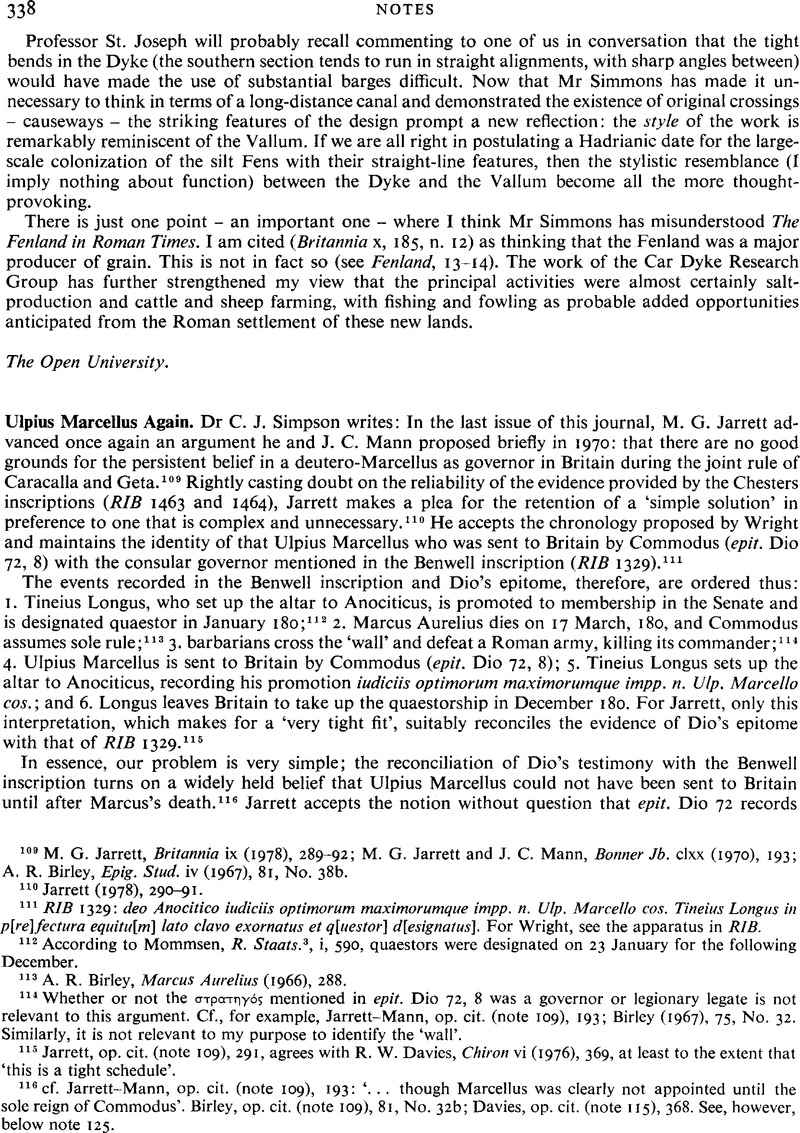No CrossRef data available.
Article contents
Ulpius Marcellus Again.
Published online by Cambridge University Press: 09 November 2011
Abstract

- Type
- Notes
- Information
- Copyright
- Copyright © Dr C. J. Simpson 1980. Exclusive Licence to Publish: The Society for the Promotion of Roman Studies
References
109 Jarrett, M. G., Britannia ix (1978), 289–92CrossRefGoogle Scholar; Jarrett, M. G. and Mann, J. C., Bonner Jb. clxx (1970), 193Google Scholar; Birley, A. R., Epig. Stud, iv (1967), 81, No. 38b.Google Scholar
110 Jarrett (1978), 290–91.
111 RIB 1329: deo Anocitico iudiciis optimorum maximorumque impp. n. Ulp. Marcello cos. Tineius Longus in p[re]fectura equitu[m] lato clavo exornatus et q[uestor] d[esignatus]. For Wright, see the apparatus in RIB.
112 According to Mommsen, R. Staats.3, i, 590, quaestors were designated on 23 January for the following December.
113 A. R. Birley, Marcus Aurelius (1966), 288.
114 Whether or not the στρατηγὁχ mentioned in epit. Dio 72, 8 was a governor or legionary legate is not relevant to this argument. Cf., for example, Jarrett-Mann, op. cit. (note 109), 193; Birley (1967), 75, No. 32. Similarly, it is not relevant to my purpose to identify the ‘wall’.
115 Jarrett, op. cit. (note 109), 291, agrees with Davies, R. W., Chiron vi (1976), 369, at least to the extent that ‘this is a tight schedule’.Google Scholar
116 cf. Jarrett-Mann, op. cit. (note 109), 193: ‘… though Marcellus was clearly not appointed until the sole reign of Commodus’. Birley, op. cit. (note 109), 81, No. 32b; Davies, op. cit. (note 115), 368. See, however, below note 125.
117 Jarrett, op. cit. (note 109), 290 and above note 116.
118 Jarrett (ibid.), 289, is surely correct in asserting that ‘the account is thematic rather than annalistic’ and that ‘it is difficult to believe that we can treat the epitomised Dio as a satisfactory guide to chronology’.
119 The rebellion lasted three months and six days, according to epit. Dio 71, 27, 32. Cassius was killed in 175 but the repercussions of the rebellion were felt at least until 178; Birley, op. cit. (note 113), 280. Commodus entered joint rule with his father on 1 January, 177.
120 Epit. Dio 72, 8: σημωπɛλάχ.
121 Epit. Dio 71, 28–9. There is no reason to doubt the validity of epit. Dio 72, 7, 4 - especially given the unusual praise here bestowed on Commodus. Martius Verus was the governor of Syria: Birley, op. cit. (note 113) 259.
122 It should be noted that Commodus as general does not figure in epit. Dio 71, even though he most certainly engaged in military affairs before the death of his father.
123 Epit. Dio 72, 8; RIC 437, 440. I find it hard to accept that the British war was the first recorded act of Commodus's reign; cf. Jarrett-Mann, op. cit. (note 109), 192 and epit. Dio 72, 1–2.
124 Epit. Dio 71, 33–4, and above, note 122.
125 Atkinson, D., JRS xii (1922), 68Google Scholar, No. 29. There is, to my mind, nothing inherently improbable in Fitz, J., A. Ant. Hung, xi (1963), 273–5Google Scholar, where it is suggested that Marcellus is to be identified with L. Ulpius Marcellus, consular governor of Pannonia Inferior perhaps as late as 174. Cf. Birley, op. cit. (note 109), 76, No. 33 and Ritterling, E., Arch. Ert. xli (1927), 290.Google Scholar
126 I have found no instance, apart from RIB 1329, where it has been suggested that two emperors, one dead and one alive, are referred to simultaneously without distinction concerning their mortal or deified state. It should be noted also that, once Marcus had died, Commodus apparently displayed little further military vigour (epit. Dio 72, 2). Perhaps, however, the need for treaties with barbarians arose from the fact that Commodus was already heavily committed in the British campaign when he assumed sole rule. If taken at face value, on the other hand, the deprecatory account is hardly consistent with the view, espoused by Jarrett, that Commodus moved swiftly to quell the British disturbances in 180. In addition, the extraordinary patience required of Tineius Longus in waiting, according to Jarrett's interpretation, several months before setting up the altar recording his promotion, is made redundant by the suggestion offered here.


